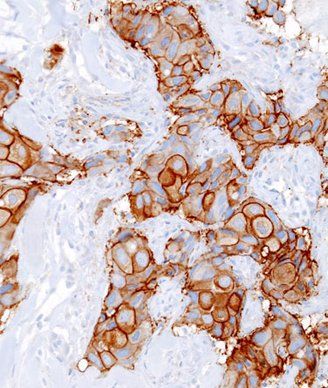Anti-HER2 Combo Active in Metastatic Breast Cancer
Dual HER2-targeted treatment with T-DM1 and pertuzumab resulted in positive antitumor activity in patients with HER2-positive, locally advanced or metastatic breast cancer, with an overall response rate of 41%.
Invasive ductal carcinoma of the breast representing a scirrhous growth. Core needle biopsy. HER-2/neu oncoprotein expression by Ventana immunostaining system. Source: KGH, Wikimedia Commons

Dual HER2-targeted treatment with trastuzumab emtansine (T-DM1) and pertuzumab resulted in positive antitumor activity in patients with HER2-positive, locally advanced or metastatic breast cancer, with an overall response rate of 41%.
According to Kathy D. Miller, MD, of Indiana University Melvin and Bren Simon Cancer Center, and colleagues, the results of this phase IIa study indicate that the combination warrants further investigation.
“The ongoing phase III MARIANNE trial, which is evaluating T-DM1 plus pertuzumab versus T-DM1 plus placebo versus trastuzumab plus a taxane in patients with HER2-positive, progressive, or recurrent locally advanced or chemotherapy naive metastatic breast cancer, will provide a definitive assessment regarding the efficacy and safety of this dual HER2-targetd combination,” they wrote in the Journal of Clinical Oncology.
Both T-DM1 and pertuzumab separately have shown positive survival results in phase II and phase III studies, and xenograft models have confirmed that when combined, the two drugs enhanced tumor inhibition. Therefore, Miller and colleagues conducted this study to test the efficacy and safety of the combination.
They enrolled 64 patients with metastatic breast cancer; 43 patients were receiving second-line or greater treatment (advanced metastatic disease) and 21 patients were in the first line. Patients were assigned to 3.6 mg/kg T-DM1 plus pertuzumab once every 3 weeks (840 mg loading dose then 420 mg subsequently). The primary endpoint was investigator-assessed objective response rate.
Overall, the objective response rate was 41%. Patients with advanced disease had a response rate of 33%; whereas, patients in the first-line had a response rate of 57%. The median progression-free survival was 5.5 months in patients with advanced disease and 7.7 months in first-line patients.
“In our current study, the objective response rate in first-line metastatic breast cancer patients (n = 21) was 57%, and the median progression-free survival was 7.7 months,” the researchers wrote. “By contrast, median progression-free survival reached 14.2 months in the randomized phase II study of first-line single-agent T-DM1 and 18.5 months with first-line pertuzumab plus trastuzumab plus docetaxel in the phase III CLEOPATRA study. However, data from our current study should be interpreted with consideration of its design as a dose-escalation and signal-seeking study, its small sample population, and the limited follow-up on progression-free survival.”
The researchers also looked at patients with retrospectively confirmed HER2-positive disease. Among those patients, the objective response rate was 32% in patients with advanced disease and 63% in patients in the first line.
The authors concluded that the two drugs “can be combined at full doses with no unexpected toxicities.”
The most commonly occurring adverse events were fatigue (61%), nausea (50%), diarrhea (39%), cough (38%), and anorexia (34%). Fifty-eight percent of patients had a grade 3 or higher adverse event.
“Despite their mechanism as HER2-targeted agents, neither T-DM1 nor pertuzumab has been associated with an increase in cardiac events to date,” the researchers wrote. “Consistent with this, the rate of cardiotoxicity observed in our current study was low, and only one patient discontinued study medication because of cardiac dysfunction (grade 2 LVEF decrease).”